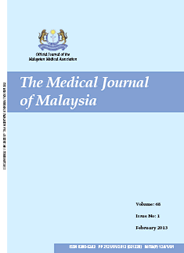MJM, Vol 70 Supplement 1 September 2015
Evaluation of environmental exposure and
leptospirosis in palm oil plantation workers
*Department of Community Medicine, School of Medical Sciences, Universiti Sains Malaysia, **Department of Medical Microbiology and Parasitology, School of Medical Sciences, Universiti Sains Malaysia
ABSTRACT
Introduction: Leptospirosis is a potentially fatal zoonotic spirochetal disease, recognised as a re-emerging public health issue that occurs worldwide but is most common in tropical and subtropical areas with high rainfall. In Malaysia, over the past decade, there has been an increased number of reported cases and outbreaks of the disease, with a significant number of deaths. The main occupational groups at risk include farm and agricultural workers. Palm oil industry is a major economic sector in Malaysia that involves a large number of agricultural workers. This study aims to determine the seroprevalence and workplace environmental exposure risk factors of leptospirosis among oil palm plantation workers in Malaysia.
Methods: Cross-sectional study of 350 palm oil plantation workers in southern Malaysia using an interviewer guided questionnaire. Blood samples were sent to Institute of Medical Research (IMR) for serological test using microscopic agglutination test (MAT). The cut-off titre for seropositive was ≥1:100.
Results. Of the 374 sampled workers, 350 participated in this study resulting in a response rate of 93.6%. The respondents were relatively young with the mean age of 31.4 (SD 9.68) years, and 50.0% had worked for more than two years in the oil palm plantation. The overall seroprevalence was 28.6%. The significant environmental risk factors found to be associated with seropositive leptospirosis were ‘presence of cows in plantation’ (adjusted Odds Ratio (aOR) 2.27; 95% CI: 1.20, 4.30), and ‘presence of landfill in plantation’ (aOR 2.04; 95% CI: 1.13, 3.70).
Conclusion. The high seroprevalence of leptospirosis show that oil palm plantation workers are at high risk for leptospirosis infection, thus increasing awareness towards the risk of this disease is vital for all stakeholders involved. Workplace environment risk factors should be considered in prevention of leptospirosis among oil palm plantation workers in future.
Keywords: Leptospirosis, oil palm plantation workers, workplace environment
